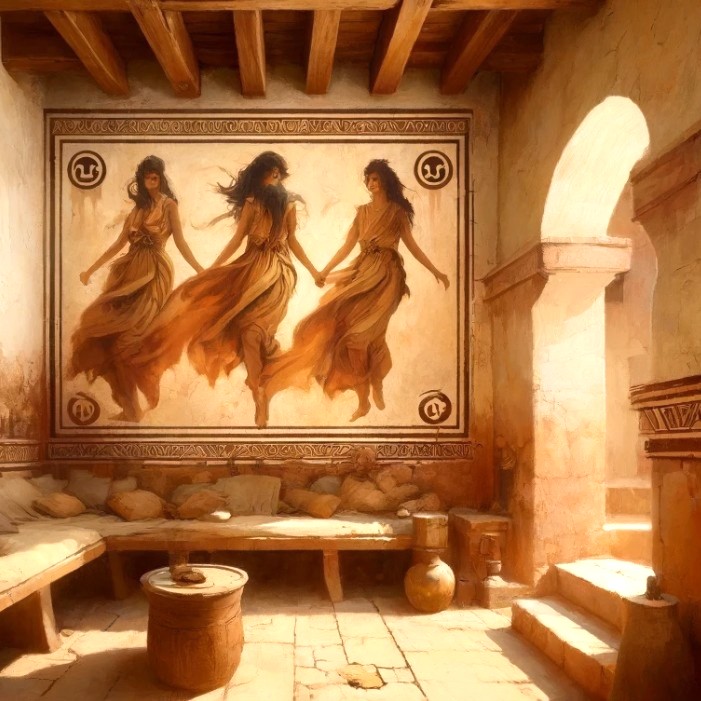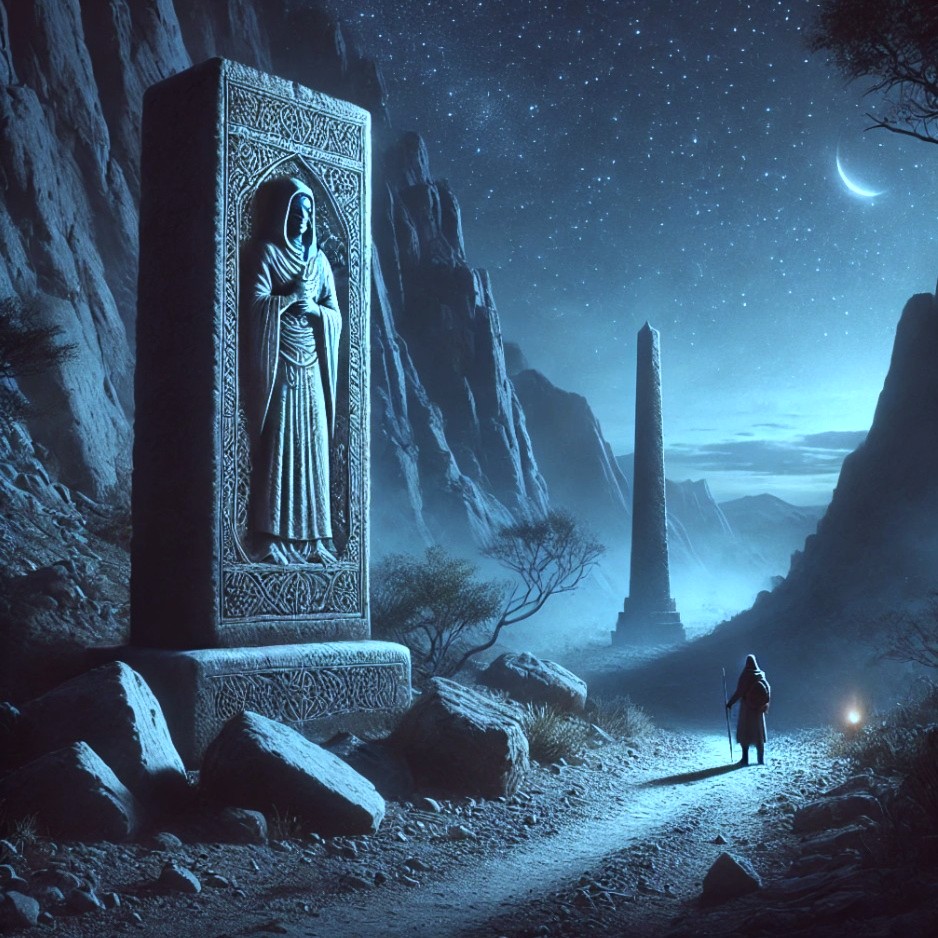Art
Art in Helerin is a vibrant and integral part of life, reflecting the diverse cultures, histories, and beliefs of its people. From the grand frescoes that adorn temple walls to the intricate carvings on a village elder’s staff, artistic expression can be found in every corner of the archipelago. Helerin’s art serves not only as decoration but also as a means of storytelling, devotion, and identity.
Artisans across Helerin work with a variety of materials - stone, metal, wood, textiles, and clay - each requiring specialized skills passed down through generations. Art is both communal and personal, with grand civic projects commissioned by rulers and modest works crafted for everyday use.

Painting and illustration
Murals and Frescoes
Murals and frescoes adorn the walls of temples, public buildings, and private residences, capturing both grand narratives and everyday scenes. Crafted using natural pigments mixed with lime plaster, these artworks often depict legendary tales, battles, and religious events, as well as fantastical creatures like Wyrms or Vashdari soaring through the skies. For instance, the Great Hall of Jaltra's Old Palace features a fresco of the first kings and queens of Remon, flanked by depictions of the gods Balcosh and Piatok blessing their rule. In the towns of Mar Mabon, simpler village frescoes show seasonal harvests or coastal life, connecting communities to their shared environment.
Book illustration and illumination
Book illumination is an artform closely tied to the literate elite, including scholars, priests, and rulers. Scribes and illuminators use fine brushes, colored inks, and gold or silver leaf to adorn manuscripts, creating intricate borders and miniature illustrations. For example, the Chronicles of the Dawnsreach features gilded depictions of explorers and mythical creatures alongside flowing script. In the temples of Forbin, illuminated holy texts are displayed during ceremonies, their vibrant illustrations of divine figures evoking awe among worshippers.Sculpture and Carving
Sculpture and carving are integral to the culture and aesthetics of the Helerin Archipelago, serving as expressions of artistry, faith, and power. Artisans work with a variety of materials, including stone, metal, and wood, to produce a diverse range of creations. Each material requires specific techniques and tools, resulting in unique works that adorn buildings, objects, and sacred spaces.Stone Sculpture
Stone is the most enduring medium, used for monumental statues, architectural embellishments, and intricate relief carvings. Grand statues of rulers and gods are a common feature in city squares and temples, while bridges and public buildings are adorned with decorative motifs like spirals, floral patterns, or guardian animals. Examples include the Fountain of Balcosh in Orbont, carved from white marble, and the sandstone statues of local heroes in Jaltra. Relief carvings often depict historical or mythical scenes, such as battles or voyages, enhancing temple walls and public monuments. Stone sculptors use chisels, mallets, and hammers to shape sandstone, alabaster, and marble. Fine details are achieved with smaller tools, while polishing stones are used to smooth the surface. Sculptors often work in teams for large projects, with apprentices handling initial shaping and masters refining details. Sculptors begin by sketching designs on the stone, sometimes using pigments to mark outlines. For large statues, scaffolding and hoists allow access to all areas, while the addition of inscriptions often falls to specialist engravers.
Metal Sculpture
Metalworking in Helerin produces a mix of functional and decorative objects, from civic sculptures to personal items. Bronze statues of gods and mythical creatures are prized for their durability and beauty. Smaller works include ceremonial items such as swords, staffs, and shields, often adorned with intricate reliefs. An example is the bronze statue of Jires in Mintrass’s harbor, standing watch over sailors. Wealthy patrons commission metal busts for their homes, while religious institutions request effigies of divine figures for altars. Metalworkers use the lost-wax casting method for large sculptures, creating wax models that are coated in clay and fired to form a mold. Molten bronze or other metals are then poured into the mold to create the final piece. Smaller objects are cast in simpler molds or hammered into shape. After casting, artisans refine surfaces by chiseling and polishing. Decorations like inlays of gold or silver, or engraved patterns, are added to enhance the design. Workshops often combine the skills of sculptors, smiths, and engravers to produce complex works.
Wood Carving
Wood carving is widely practiced and produces both practical and ornamental objects. Artisans craft furniture, decorative panels, ceremonial staffs, and small figurines. Items often feature animal shapes, geometric patterns, or mythical motifs. In coastal regions, figureheads carved for ships often depict sea creatures or protective spirits. In temples, elaborately carved wooden screens separate sacred spaces, while rural homes might feature wooden beams decorated with floral motifs. Smaller works, like amulets and charms, are carried by travelers or hung in homes for protection. Carvers work with hardwoods like oak, often using knives, chisels, and gouges. Patterns are marked on the wood before carving begins, and fine details are added using smaller tools. Surfaces are smoothed and finished with natural oils or wax to preserve the material and enhance its beauty. Larger projects, such as furniture or architectural carvings, involve multiple artisans working in stages. Carved items are sometimes painted or gilded, especially in religious or ceremonial contexts.
Decorative Pottery and Ceramics
Painted Vases and Ceramics
Ceramic artisans create painted vases, jugs, and tiles that combine functionality with artistry. These often feature geometric patterns, stylized animals, or depictions of daily life. In Gilrim, cobalt-blue ceramic tiles adorn the walls of wealthy homes, contrasting with the reddish clay pottery used in village markets. See also: Pottery and ceramics
Decorative Jewellery
Jewellery in Helerin showcases the skill of metalworkers and gem-cutters. Crafted from gold, silver, and bronze, and adorned with gemstones like amethyst and turquoise, these pieces are both decorative and symbolic. Necklaces shaped like serpents or birds are favored by aristocrats, while warriors wear armlets bearing the sigils of their houses. See also: Jewellery
Textiles
Tapestries and Banners
Textile art is a major form of storytelling, with banners and tapestries displaying scenes of history, mythology, or nature. The Banner of the Golden King in Holdras, for instance, shows Trybon Fane leading his knights into battle, its gold thread gleaming in torchlight. See also@ TextilesClothing and Emblems
Clothing often incorporates embroidered emblems, such as a lion for a noble house or geometric patterns reflecting a region’s heritage. In Mar Miskun, nomadic peoples embroider their cloaks with bright animal motifs to ward off evil spirits. See also: Clothing
Mosaic
Mosaics are a striking feature of temples, baths, and wealthy homes, where they decorate floors and walls. Artisans use small pieces of colored stone or glass to create elaborate patterns or images. The Hall of Winds in Mintrass features a mosaic of a ship sailing on stormy seas, its sails billowing under the watchful eyes of Jires. Simpler mosaics in rural temples may depict animal guardians or geometric patterns symbolizing prosperity.



Comments